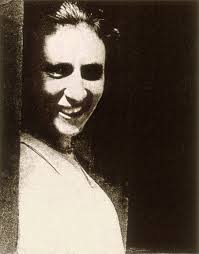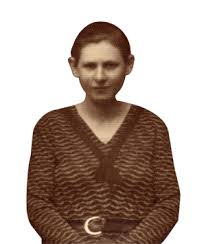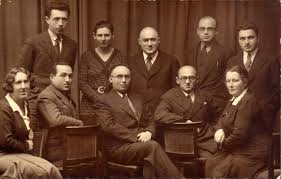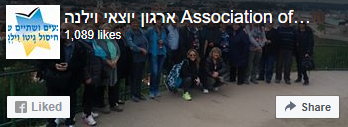Mira Bernstein
 The first of September symbolizes for all of us the beginning of the school year, but for some of us also the outbreak of World War II: 01/09/39. The connection between the two events finds its essence in the poem Teacher Mira written by Avraham Sutzkever in the Vilna Ghetto in May 1943, dedicated to his 'life teacher," Mira Bernstein, director of the elementary wing of Vilna's Hebrew (Real) Gymnasiya .
The first of September symbolizes for all of us the beginning of the school year, but for some of us also the outbreak of World War II: 01/09/39. The connection between the two events finds its essence in the poem Teacher Mira written by Avraham Sutzkever in the Vilna Ghetto in May 1943, dedicated to his 'life teacher," Mira Bernstein, director of the elementary wing of Vilna's Hebrew (Real) Gymnasiya .
Mira Bernstein was born in Vilna in 1908, when Vilna was part of Poland during the period between the two world wars. She studied at a Yiddish teachers' seminary and later became a teacher in the city. In 1939, she was appointed director of the Real Gymnasiya in Vilna. On September 6, 1941, she marched with her students into the second ghetto. That evening, Mira gathered her students and read them a story written by Shalom Aleichem. The ghetto deportation was violent and cruel; it happened after the great provocation on August 31, where 8,000 Jews were murdered in Ponar. The reading of the story that evening was Mira's first attempt to keep the students sane.
She re-established the Real Gymnasia inside the ghetto, in the small ruined undertakers' prayer house in the Schulhof. The school had 130 students with classes according to the level of development.
The teacher system involved rotation: a group to cook and mend clothes, and parallel to it, a second group teaching literature and song. For the students, the teachers replaced their lost parents.
Every morning, Mira used to count the children, and every morning their number was smaller. Mira ran the school under the threat of perpetual death. In October 1941, Mira put on a play at her school.
Out of 130 students, only 40 remained. In the middle of the play, a noise was heard, but Mira did not stop the play. When the shooting began, Mira went outside and saw how the abductions were taking place on the street. Mira took to the stage and announced:
"Children, those who want to kill us are now inside the ghetto. Do not shout, do not run away. Quietly, without making any noise, crawl and hide under the stage. The youngest will enter first, and so on until the last of you according to the age." (Vilna Ghetto /Avraham Sutzkever /Am Oved, p. 130).
All night Mira stood guard near the door. She thought that if the kidnappers were to come, they would be satisfied with her, and would not demand the children. The kidnappers did not enter the small synagogue that night.
At the time of the second ghetto liquidations at the end of October, Mira had only 7 students left out of 130. She transferred the remaining seven students to the first ghetto.
Mira was also a member of the Bund Movement, and joined the United Partisan Organization (FPO) in the ghetto. As the ghetto liquidation date approached, Bernstein refused to evacuate through the sewers due to her health condition, and not wanting to be a burden on her friends.
Upon the liquidation of the ghetto, Bernstein was sent to Majdanek, where she perished.
Mira, a "life teacher", tried to create the illusion of normality for her students. She tried to ensure that the children would not leave the ghetto emotionally disturbed, but proud, aware, healthy and able to continue working. She believed that redemption was near and tried to insert this belief into her students' hearts. In this catastrophic situation, Mira was indeed a significant life and death teacher.
Teacher Mira
With patches on our bodies, striped and parching,
They chase us in the ghetto, streets are marching,
Our buildings say farewell eternally,
Stone faces walk with us at each decree.
Old people wearing tfillin like black crowns,
A calf walks with a village Jew in tow,
A woman drags a person by the nails,
Another pulls a bunch of wood on rails.
Among them walks a woman, Teacher Mira.
A child is in her arms — a golden lyre.
She clasps another child by his frail hand,
The students walk around her — trusting band.
And as they get to Jew Street, there's a gate,
The wood still warm and raw, they huddle, wait.
And like a sluice for torrents of a flood,
It opens up and swallows in its blood.
They chase us over ruins, no bread, no light,
Bread is a book, a pencil shines so bright.
She gathers all her children on the floor,
Teacher Mira goes on teaching as before.
She reads Sholem Aleichem's tale aloud,
A sparkle in their eyes, they laugh so proud.
She ties blue ribbons in the girls' braids
And counts her treasures: hundred thirty heads.
And Teacher Mira, like the sun, at dawn
Awakes, waits for her children to go on.
They come. She counts. Oh, better not to count!
For overnight, some twenty were cut down.
Her skin, a windowpane in stains of dusk,
Mira must not reveal the darkness thus.
She bites her lip, of courage she will tell:
About Hirsh Lekert, how he fought and fell.
And overnight, gray covered all the town,
And Teacher Mira's hair, her silver crown.
She seeks in cellars for her mother blind,
And seventeen more children she can't find.
When sun dried up the blood, with branches green
She trimmed the orphaned room, so neat and clean:
— Gershteyn the teacher came and we shall sing,
Over the walls, our children's choir will ring.
They sing: "Not far is spring." But in the street,
Axes and bayonets smash, crush, and beat.
They drag from cellars, hidings, but the choir
Sings on "Not far is spring," sings higher, higher.
They are but sixty, with no sister, mother,
Now Teacher Mira is one and the other.
A holiday approaches, little doves,
We shall prepare a play, a play she loves.
The fête — and only forty children left.
But each in a white shirt, each child bereft.
The stage is fresh, a garden in the sun,
A river you can swim in, you can run.
When Peretz's third gift took all the bows,
The peril has cut down the rickety house.
People were caught by snatchers! Save us, Heaven!
Of a hundred thirty, Mira remains with seven.
Till axes split her mind, she on her knees,
A flower, and her children — buzzing bees.
Gray is the flower, and the time is awesome.
Tomorrow in the dew, again she'll blossom.
Sutzkever, Vilna Ghetto, May 10, 1943



